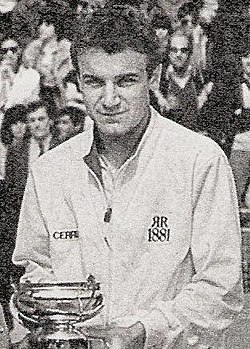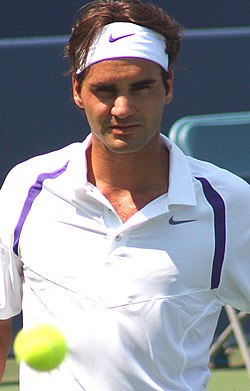User:Don Lope/Sandbox Australian Open

The Australian Open[a] is an annual tennis tournament created in 1905 and played on outdoor hard courts[b][c] at Melbourne Park in Melbourne, Australia.[1] The men's singles was one of the two first events contested in 1905. The Australian Open is played during two weeks mid-January, and has been chronologically the first of the four Grand Slam tournaments of the tennis season since 1987. The event was not held from 1916 to 1918 because of World War I, from 1940 to 1945 because of World War II, and in 1986 because of a date change.[2][3]
Christchurch and Hastings, New Zealand, and Perth, Brisbane, Adelaide, Sydney, and Melbourne, Australia all held the event, which switched location every year before it settled in 1972 at the Kooyong Stadium, moving to Flinders Park, now Melbourne Park, in 1988.[2] Several calendar changes also took place for the Australian Open, from January to December in 1972 to bypass the January-to-June International Lawn Tennis Federation (ITLF) ban of World Championship Tennis (WCT) players; from late to early December in 1977 to avoid the Christmas holidays, which resulted in having two Opens in the season[4]; and back to January, when the planned December 1986 edition was moved to early 1987, leaving no Open for the 1986 season.[5][6]
The men's singles' rules have undergone several changes since the first edition. Since the first championships, the event has been contested in a knockout format, and all matches played at the best-of-five sets, except in 1970, 1973, and 1974, when the first round was played at the best-of-three.[1] All sets were decided since 1905 in the advantage format, with six games and two games difference. The lingering death best-of-twelve points tie-break was introduced in 1971, and used for the first four sets since then, except from 1980 to 1982, when the tie-break was also played in fifth sets.[1][7] The court surface changed once, from grass (1905–1987) to hard courts, since the move to Flinders Park in 1988.[2][8][9]
The champion receives a miniature replica of the silver-gilt Norman Brookes Challenge Cup, named after the 1911 champion, and former Lawn Tennis Association of Australia (LTAA) president, and modeled after the Warwick Vase.[10] In 2009, the winner received prize money of A$2,000,000.[11]
Roy Emerson (winner, 1961, 1963–1967) holds both the record for most titles with six victories, and for most consecutive titles with five from 1963 to 1967.[3]
Champions
[edit]






| Regular competition |
| No competition • |
Statistical information
[edit]




Multiple champions
[edit]| Active player + |
| Player | Amateur Era | Open Era | All-time | Years |
|---|---|---|---|---|
| 6 | 0 | 6 | 1961, 1963, 1964, 1965, 1966, 1967 | |
| 0 | 4 | 4 | 1995, 2000, 2001, 2003 | |
| 4 | 0 | 4 | 1931, 1932, 1933, 1935 | |
| 2 | 2 | 4 | 1953, 1955, 1971, 1972 | |
| 3 | 0 | 3 | 1922, 1924, 1925 | |
| 0 | 3 | 3 | 2004, 2006, 2007 | |
| 2 | 1 | 3 | 1960, 1962, 1969 | |
| 3 | 0 | 3 | 1936, 1940, 1948 | |
| 0 | 3 | 3 | 1983, 1984, 1988 | |
| 0 | 2 | 2 | 1991, 1996 | |
| 2 | 0 | 2 | 1939, 1946 | |
| 2 | 0 | 2 | 1957, 1958 | |
| 0 | 2 | 2 | 1992, 1993 | |
| 0 | 2 | 2 | 1985, 1987 | |
| 2 | 0 | 2 | 1905, 1910 | |
| 0 | 2 | 2 | 1981, 1982 | |
| 0 | 2 | 2 | 1989, 1990 | |
| 0 | 2 | 2 | 1973, 1975 | |
| 0 | 2 | 2 | 1994, 1997 | |
| 2 | 0 | 2 | 1949, 1950 | |
| 0 | 2 | 2 | 1978, 1979 | |
| 2 | 0 | 2 | 1906, 1909 | |
| 2 | 0 | 2 | 1920, 1923 |
Champions by country
[edit]| Former country ¤ |
| Country | Amateur Era | Open Era | All-time | First title | Last title |
|---|---|---|---|---|---|
| 44 | 6 | 50 | 1905 | 1976 | |
| 4 | 14 | 18 | 1908 | 2003 | |
| 0 | 6 | 6 | 1983 | 2002 | |
| 5 | 0 | 5 | 1912 | 1934 | |
| 0 | 3 | 3 | 2004 | 2007 | |
| 0 | 2 | 2 | 1978 | 1979 | |
| 0 | 2 | 2 | 1989 | 1990 | |
| 0 | 2 | 2 | 1991 | 1996 | |
| 2 | 0 | 2 | 1906 | 1909 | |
| 0 | 2 | 2 | 1999 | 2005 | |
| 0 | 1 | 1 | 1998 | 1998 | |
| 0 | 1 | 1 | 1928 | 1928 | |
| 0 | 1 | 1 | 2008 | 2008 | |
| 0 | 1 | 1 | 1981 | 1981 | |
| 0 | 1 | 1 | 2009 | 2009 |
Notes
[edit]- a Known as the Australasian Championships (1905–1926) and as the Australian Championships (1927–1968) during the Amateur Era.[2]
- b Since 1988, Rod Laver Arena features a retractable roof and lights, allowing indoor and night-time play.[12]
- c The Australian Open specifically uses Plexicushion Prestige hard courts, categorized as a "Medium" speed surface by the International Tennis Federation (ITF).[15][8][9]
- d Each year is linked to an article about that particular event's draw.
- e The tournament was not held from 1916 to 1918 because of World War I.[3]
- f The tournament was not held from 1941 to 1945 because of World War II.[3]
- g Although he was still a Peruvian citizen, Alex Olmedo was recorded as an American competitor for the 1959 Australian Championships.[16][17]
- H The tournament entered the Open Era with the 1969 edition, allowing professional players to compete alongside amateurs.[2]
- i Two Australian Opens were in held in 1977 because of a date change, the first in January and the second in December.[4]
- j The tournament was not held in 1986 because of a date change.[5][6]
- k Ivan Lendl won the final after Stefan Edberg retired because of a strained abdominal muscle.[18]
- l Three wins by players from the United Kingdom of Great Britain and Ireland (1801–1922), plus two wins by players from the United Kingdom of Great Britain and Northern Ireland (1922–present).
- m Czechoslovakia (TCH, 1918–1992), does not include the totals of Czech Republic (CZE, 1992–present) and Slovakia (SVK, 1992–present).
- n Czech Republic (CZE, 1992–present), does not include the totals of Czechoslovakia (TCH, 1918–1992), nor Slovakia (SVK, 1992–present).
References
[edit]- General
- "Grand Slam Tournaments - Australian Open" (PDF). usta.com. United States Tennis Association. Retrieved 2009-07-01.
- "List of Australian Open men's champions". ESPN.com. Reuters. 2009-02-01. Retrieved 2009-07-01.
- Specific
- ^ a b c "Tournament profile - Australian Open". atpworldtour.com. ATP Tour, Inc. Retrieved 2009-07-05.
- ^ a b c d e Foenander, Tristan. "History of the Australian Open – the Grand Slam of Asia/Pacific". australianopen.com. IBM, Tennis Australia. Retrieved 2009-07-01.
- ^ a b c d "Grand Slam Tournaments - Australian Open" (PDF). usta.com. United States Tennis Association. Retrieved 2009-07-01.
- ^ a b "1977 Grand Slam calendar". atpworldtour.com. ATP Tour, Inc. Retrieved 2009-07-01.
- ^ a b "1986 Grand Slam calendar". atpworldtour.com. ATP Tour, Inc. Retrieved 2009-07-01.
- ^ a b "Australian Open - History - Year-by-year". australianopen.com. IBM, Tennis Australia. Retrieved 2009-07-01.
- ^ "Roddick survives 83-game epic". The Guardian. Guardian Media Group. 2003-01-22. Retrieved 2009-07-01.
- ^ a b c Schlink, Leo (2008-01-14). "Plexicushion replaces Rebound Ace at Australian Open". Herald Sun. The Herald and Weekly Times. Retrieved 2009-07-01.
- ^ a b c d Bevan, Chris (2008-01-11). "On-court blues for Aussie tennis?". BBC Sport. BBC. Retrieved 2009-07-01.
- ^ Vaughan, Gerard (2005-01-17). "Trophy has roots in an 18th-century antiquity". The Age. The Age Company Ltd. Retrieved 2009-07-01.
- ^ "Australian Open - Prize Money". australianopen.com. IBM, Tennis Australia. Retrieved 2009-07-01.
- ^ a b "Rod Laver Arena". mopt.com.au. Melbourne & Olympic Parks. Retrieved 2009-08-02.
- ^ Pearce, Linda (2009-01-30). "Let's call time on late-night tennis". The Age. The Age Company Ltd. Retrieved 2009-08-02.
- ^ Clarey, Christopher (2009-02-02). "Nadal defeats a tearful Federer in Australia". The New York Times. The New York Times Company. Retrieved 2009-08-02.
- ^ "List of Classified Court Surfaces". itftennis.com. ITF Licensing. Retrieved 2009-08-01.
- ^ "Aching, Victorious Olmedo to Forsake Tennis for Study". Chicago Tribune. Tribune Interactive, Inc. 1959-01-27. Retrieved 2009-08-02.
- ^ "List of Australian Open men's champions". ESPN.com. Reuters. 2009-02-01. Retrieved 2009-07-01.
- ^ Bick, Nina (1990-01-29). "Lendl Wins Title as Edberg Pulls Out". The New York Times. The New York Times Company. Retrieved 2009-08-02.
External links
[edit]
